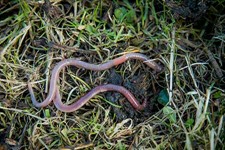Manure injection detrimental to meadow birds
On farmland where liquid manure is injected into the soil, the amount of earthworms is lower than on tracts of land where rough farmyard manure is used. The cutting open of the grass surface during injection causes the top soil to dry out to such an extent that worms are no longer found at the surface. In farmland areas where this method is applied, meadow birds feeding on worms find this source of nutrition considerably diminished. These findings are demonstrated by University of Groningen researcher Jeroen Onrust in a publication appearing in the Journal of Applied Ecology.
Soil moisture essential for presence of worms
Moisture in the top layer of the soil ensures that earthworms are able to come to the surface and also that meadow birds can peck into the soil. “To help the worms and meadow birds in areas of dried-out farmland, an often-used approach is to raise the groundwater level”, says UG researcher Jeroen Onrust. “But if the soil has already been perturbed as a result of manure injection – among other causes – the top layer will dry out so fast in springtime that a raised groundwater level no longer helps”, adds Prof. Theunis Piersma.

Red and grey earthworms
In Dutch farmland soil, two types of earthworm are prevalent: the first, the grey Aporrectodea caliginosa, feeds on bacteria that live on the surface of soil particles. The other type, the red Lumbricus rubellus, commutes back and forth between the subsoil and the surface, where the earthworm retrieves plant remains to be digested deeper underground. As a result of this behaviour, the red earthworms are particularly important for a good soil structure and as a source of nutrition to meadow bird species.
From the field to the laboratory
In an earlier publication this year in Agriculture, Ecosystems and Environment, Onrust showed that tracts of land that have been injected with liquid manure are less hospitable to red earthworms than soils on which rough farmyard manure is applied. To rule out the possibility of other reasons as to why the latter, rough manured tracts of land are better habitats for worms, Onrust performed a number of laboratory experiments. “We’ve put young grey and red worms on a five-month diet of liquid manure, rough farmyard manure or plain straw. The experiment clearly showed that red worms didn’t grow as fast when feeding on liquid manure as they did on farmyard manure. This means that there are two reasons why the injection of liquid manure causes the dwindling of the ecologically important red worms: such grasslands don’t contain enough nutritious material for them, and the soil surface becomes too dry.”

Publications
- Onrust, J. & Piersma, T. (2019) How dairy farmers manage the interactions between organic fertilizers and earthworm ecotypes and their predators. Agriculture, Ecosystems and Environment 273, 80-85: https://doi.org/10.1016/j.agee.2018.12.005
- Onrust, J., Wymenga, E., Piersma, T. & Olff, H. (2019) Earthworm activity and availability for meadow birds is restricted in intensively managed grasslands. Journal of Applied Ecology: https://besjournals.onlinelibrary.wiley.com/doi/10.1111/1365-2664.13356
| Last modified: | 25 February 2022 10.08 a.m. |
More news
-
21 November 2024
Dutch Research Agenda funding for research to improve climate policy
Michele Cucuzzella and Ming Cao are partners in the research programme ‘Behavioural Insights for Climate Policy’
-
13 November 2024
Can we live on our planet without destroying it?
How much land, water, and other resources does our lifestyle require? And how can we adapt this lifestyle to stay within the limits of what the Earth can give?
-
13 November 2024
Emergentie-onderzoek in de kosmologie ontvangt NWA-ORC-subsidie
Emergentie in de kosmologie - Het doel van het onderzoek is oa te begrijpen hoe ruimte, tijd, zwaartekracht en het universum uit bijna niets lijken te ontstaan. Meer informatie hierover in het nieuwsbericht.
